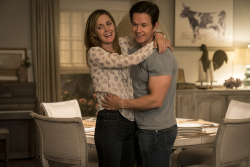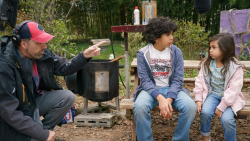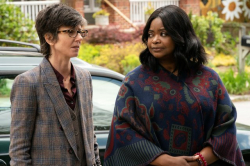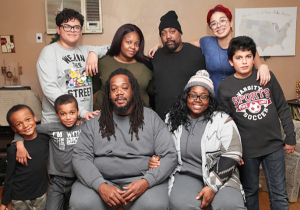 Last year a real Hollywood movie was made on our street.
Last year a real Hollywood movie was made on our street.
It came out early this year, and Wikipedia says it grossed $120 million. It found life on Amazon Prime and, when I saw it was available, I gave it a look.
The film stars Mark Wahlberg and Rose Byrne as childless adults who spent a month being driven up and down the street in black cars on their way to filming. Primary filming was done at 262 Winter. We’re at 215. Our house was never shown.
I remember 262 from back in the day, in the early 1990s, before the neighborhood became gentrified. It was barely a shell when a man named Michael bought it and renovated.
Some history. These houses all look like Craftsman barns, a central beam and a roof that slopes to the sides. My son John calls them “double-barreled shotgun shacks.” The homes on the east side were built around 1908, in the City of Oakhurst. Oakhurst folded in 1915, and the homes were joined to Decatur. Those homes on the west side were built in the early 1920s, when the City of Kirkwood folded and became part of Atlanta. Our house dates from 1923. The developer of the Oakhurst homes was a woman in Kirkwood named Lavinia Winter. Hence the name Winter Avenue.
 Michael’s renovation was unique. He took out the central beam, bracing the roof laterally, and turned what were 6-8 rooms into one big room. Eventually he put in walls at the corners to make bedrooms, but other than that the space is open. The film makers used this to convey the impression of rooms, and to let the characters move around while the cameras were hidden.
Michael’s renovation was unique. He took out the central beam, bracing the roof laterally, and turned what were 6-8 rooms into one big room. Eventually he put in walls at the corners to make bedrooms, but other than that the space is open. The film makers used this to convey the impression of rooms, and to let the characters move around while the cameras were hidden.
The outside of 262 still looks a little ratty, even 20 years after the work was done. I like it. So does the family that lives there. (They got enough money out of it to rent another house and take in a tidy profit.) But the film makers also decided to use their exterior, including the yard, to represent a “bad” foster home the kids were removed from. It was strange to watch the “kids” walk into the yard from what I know is a basement apartment. There was once a garage there, and the family gardens the space, but the filming was done when the yard is its most unattractive, in early spring. The filmmakers used that to represent how “bad” the foster parents were.
The house next door, at 266, was also used for some interiors, like kitchen scenes. Cameras were set in the back of the space, and actors moved in through an open gap.

The plot is that Wahlberg and Byrne have never thought of having kids and are thus persuaded in mid-life to become foster parents. They’re introduced to a teenager, played by Isabela Moner, and are told she’s part of a set of 3 by Octavia Spencer and Tig Notaro, playing social workers. The rest of the movie is the struggle of these 5 people to connect.

The whole point of the movie is to encourage adults to foster, and there’s a huge need for it. There are lots of speeches that aren’t set up like speeches from Notaro, and there’s a collection of other adults working to foster as well. These are obvious set-ups and stereotypes. There’s a gay couple, and a woman who wants to parent a great athlete like Sandra Bullock in The Blind Side.
Sadly, the movie goes off-track near the end for three reasons:
-
Money – No one talks about it. The foster parents are all seen as rich, the kids and their parents as poor. That’s not always the case. Money is always an issue. It’s asinine not to go into the issue, especially since the kids are usually black or Hispanic, and the fosters nearly all white.
- Neighbors – There’s only one person playing a neighbor, who appears in a very late scene. Moner runs behind her house to hide so Wahlberg and Byrne can have an emotional scene getting back together. This was fun for me, because she supposedly runs out of a house near the top of Madison, then down the hill where they run the soap box derby, before suddenly appearing behind at house on Johnston Road, which is in the other direction. When the scene ends the family all walks up Winter, in the direction of our house.
- The Ending – It’s just saccharine and wrong. First, everyone in the foster group, and their kids, and the people who work in the court, get into the picture when the adoption takes place? Really? Second, the “success” of the family is represented by their moving into a giant suburban palace, out of my neighborhood. This is foreshadowed by Moner helping Wahlberg with a kitchen demolition – Wahlberg’s character is a real estate flipper.

When we moved to Winter Avenue, this was an entirely black neighborhood. I was raised by these people. So were my kids. It takes a neighborhood to raise great kids. It’s not all about the parents.
That would have been the message of a better picture. This one missed the mark because the only characters were rich whites, poor blacks and big government. It was racist, classist, and left me feeling frustrated. Also, it took place in California. (California?)
But it was cool to watch the movie people at work and know that Moner will have some good memories of my street when she’s older and winning Oscars. I just wish the writers had respected the place a bit more.











